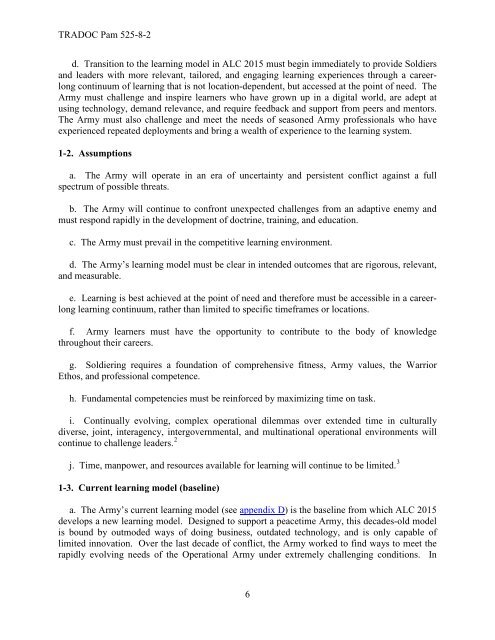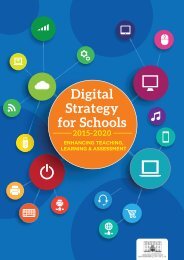K3zgZ
K3zgZ
K3zgZ
You also want an ePaper? Increase the reach of your titles
YUMPU automatically turns print PDFs into web optimized ePapers that Google loves.
TRADOC Pam 525-8-2<br />
d. Transition to the learning model in ALC 2015 must begin immediately to provide Soldiers<br />
and leaders with more relevant, tailored, and engaging learning experiences through a careerlong<br />
continuum of learning that is not location-dependent, but accessed at the point of need. The<br />
Army must challenge and inspire learners who have grown up in a digital world, are adept at<br />
using technology, demand relevance, and require feedback and support from peers and mentors.<br />
The Army must also challenge and meet the needs of seasoned Army professionals who have<br />
experienced repeated deployments and bring a wealth of experience to the learning system.<br />
1-2. Assumptions<br />
a. The Army will operate in an era of uncertainty and persistent conflict against a full<br />
spectrum of possible threats.<br />
b. The Army will continue to confront unexpected challenges from an adaptive enemy and<br />
must respond rapidly in the development of doctrine, training, and education.<br />
c. The Army must prevail in the competitive learning environment.<br />
d. The Army’s learning model must be clear in intended outcomes that are rigorous, relevant,<br />
and measurable.<br />
e. Learning is best achieved at the point of need and therefore must be accessible in a careerlong<br />
learning continuum, rather than limited to specific timeframes or locations.<br />
f. Army learners must have the opportunity to contribute to the body of knowledge<br />
throughout their careers.<br />
g. Soldiering requires a foundation of comprehensive fitness, Army values, the Warrior<br />
Ethos, and professional competence.<br />
h. Fundamental competencies must be reinforced by maximizing time on task.<br />
i. Continually evolving, complex operational dilemmas over extended time in culturally<br />
diverse, joint, interagency, intergovernmental, and multinational operational environments will<br />
continue to challenge leaders. 2<br />
j. Time, manpower, and resources available for learning will continue to be limited. 3<br />
1-3. Current learning model (baseline)<br />
a. The Army’s current learning model (see appendix D) is the baseline from which ALC 2015<br />
develops a new learning model. Designed to support a peacetime Army, this decades-old model<br />
is bound by outmoded ways of doing business, outdated technology, and is only capable of<br />
limited innovation. Over the last decade of conflict, the Army worked to find ways to meet the<br />
rapidly evolving needs of the Operational Army under extremely challenging conditions. In<br />
6




